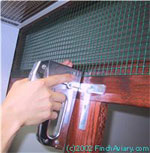|
It
is important to provide proper ventilation for birds kept
in an acrylic aviary. In addition to promoting air exchange,
the ventilation panels also act as sound ports, allowing
you to better enjoy the aviary sounds. I chose to put
the ventilation panels at the top of the aviary so that
it would be very unlikely any aviary debris will escape
from the aviary through the mesh.
In
the past, I've used regular hardware cloth for ventilation
in the temporary aviary and in the flight cage. I've since
read an article describing the dangers of zinc poisoning
when using hardware cloth to make cages: Galvanized
Wire and Zinc by Dan Radovich. This article convinced
me I might be better off finding a good alternative, even
though I have never had a death in the flight cage in
two years of use with ventilation panels made of hardware
cloth. I have a feeling the risks from using hardware
cloth are much greater when you house birds like hookbills
that like to chew and climb using their beaks, especially
if all walls are made of the mesh. However, I want to
provide the safest possible environment for my birds,
and it sounded like standard hardware cloth was not it.
|
What
I found was green vinyl-coated hardware cloth, available
at Menards. This hardware cloth was totally covered
in green vinyl and should therefore protect my birds
from any zinc that may be in the wire itself. Since
finches will not chew through the vinyl, there should
be no danger. This is just my supposition, however,
and I have never found any information regarding
vinyl coated hardware cloth and bird safety. It
is also very nice looking. It gave the aviary a
more polished look than the standard exposed hardware
cloth would. Note that vinyl coated hardware cloth
would not be suitable for hookbills that chew, as
they could easily chew off the vinyl coating, exposing
the wire and making the ventilation panels unsightly.
I
have heard of people using plastic hardware cloth
to make cages and aviaries. Plastic hardware cloth
should never be used in an outdoor aviary, as predators
can easily chew through the plastic to gain access
to the birds. It is perfectly fine for an indoor
aviary, however. I am unsure as to whether the vinyl-coated
hardware cloth is suitable for outdoor aviaries,
as I have not seen any information on this.
|
|
Installation
of the hardware cloth was simple. The hardware cloth
was cut with a wire cutter into rectangles slightly
larger than the openings in the aviary front. The
hardware cloth was flattened by hand, then stapled
to the inside of the aviary front with a staple
gun, making sure to keep the piece straight across
the opening so that the grids do not appear crooked.
|
 The
aviary, with ventilation panels installed
The
aviary, with ventilation panels installed |
|
|



